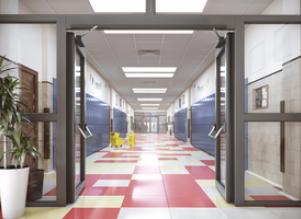10/27/2019
Dyslexia School? New Yorkers Try New Approach for Students
In September 2019, a new publicly funded charter school opened on New York City's Staten Island with a unique mission—catering to “students with language-based learning disabilities such as dyslexia,” according to an article from local news outlet The City.
Although Bridge Preparatory Charter School is starting small, with 90 first- and second-grade students, supporters say it will be tapping into a big need: better serving the high percentage of students who struggle with reading but have few avenues of support. Indeed, reporters Alex Zimmerman and Yoav Gonen of The City framed the school’s opening as “the climax of a yearslong battle for parents, advocates, and elected officials” who have seen too many children grapple with frustration and failure in the classroom.
Dyslexia—the most common cause of reading, writing, and spelling difficulties—is by no means the only language-based learning disability out there, although it is the most well known. In fact, 15% to 20% of the national student population has a language-based learning disability, and of those with specific learning disabilities who receive special education services, 70% to 80% have deficits in reading. The numbers are staggering, especially given the growing correlation between strong reading and writing skills with future school and career success.
In light of these figures, Bridge Preparatory's debut is a bold stroke designed to force the New York public school system to invest in science-based literacy instruction. Here’s a look at how this school came to be, as well as how it connects to broader issues of literacy, reading, and action over passive acceptance.
A hybrid or a mishmash?
The opening of Bridge Preparatory is only the latest chapter of a seemingly endless debate over how best to help all students learn to read. As Zimmerman and Gonen noted, New York City adopted a “balanced literacy” approach to reading instruction nearly two decades ago that emphasized the joy of reading and positioned the activity as a naturally occurring phenomenon that most kids will embrace on their own.
Some see balanced literacy as a comfortable middle ground between phonics instruction—which teaches students how to decode words and make that essential connection between letters, sounds, and words—and a whole language approach. The latter, in the words of Scott Willis of the Association for Supervision and Curriculum Development, “discredited [phonics instruction's] part-to-whole approach” by instead immersing students in language and literature, with the assumption that independent reading skills would follow for most.
But although balanced literacy is sometimes thought of as a hybrid of the two instructional styles, many researchers have concluded that it is more of a mishmash than a useful pairing. Moreover, balanced literacy does not incorporate the Orton-Gillingham approach and similar multisensory, skills-based instructional methods that are widely considered to be beneficial for emerging readers and those struggling with a learning disability such as dyslexia.

Before Bridge Preparatory, area parents whose children struggled with reading were faced with an array of daunting prospects, including the following:
-
Confusing diagnoses: Although students at public schools were screened when their literacy struggles became apparent, these screenings did not yield clear diagnoses, as public-school staff were only allowed to more generally identify students as having a “learning disability.” (This has since changed, thanks to the passage of a new law that makes it easier for parents to advocate on their children's behalf.)
-
Long bus rides: Some elementary-school students on Staten Island had to ride the bus for as long as three hours a day to attend a private school that provided evidence-based support for students with dyslexia and other learning disorders.
-
Expensive, state-funded alternatives: The federal Individuals with Disabilities Education Act (IDEA) requires public schools to provide all students with a free, appropriate education that includes special education services, as necessary. Under pressure from parents and caregivers to provide services such as specific reading instruction, some schools turned to the state to fund their alternative programming. In New York, this meant the government was contributing millions in private school tuition fees for a small group of students rather than ensuring every public school was equipped to meet all students' needs.
The way of the future?
Against a backdrop of widespread national dismay over stagnant literacy rates and reading scores, particularly among students from marginalized communities, researchers and other education professionals have expressed frustration with a perceived lack of evidence-based reading instruction. At Bridge Preparatory, such instruction is provided to all students for free, making the new school something of a test case for the aforementioned Orton-Gillingham approach and the broader guiding principles of “direct, systematic, explicit” instruction shown to improve reading levels for many students—particularly those who have struggled to obtain foundational literacy skills.
Founding a separate school to provide adequate, enriching, and appropriate support for students with dyslexia and other language-based disorders may seem like a drastic step, but for families embroiled in the "yearslong battle" referenced by Zimmerman and Gonen, Bridge Preparatory couldn't open its doors soon enough.

